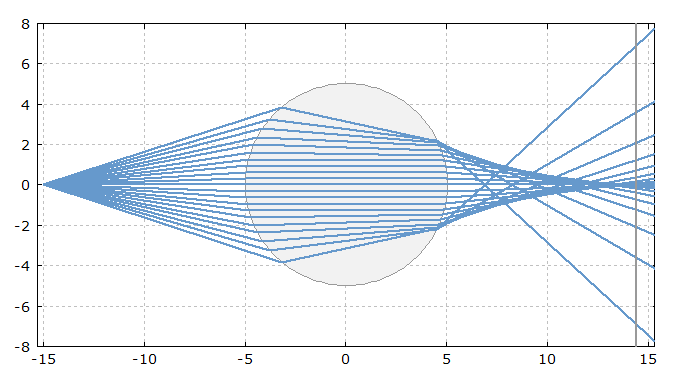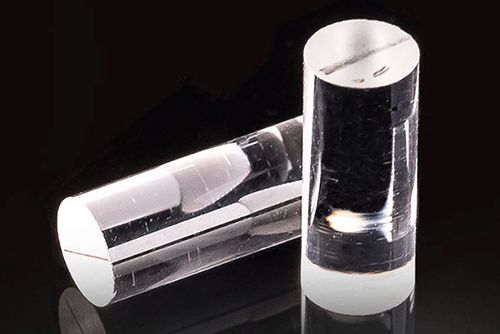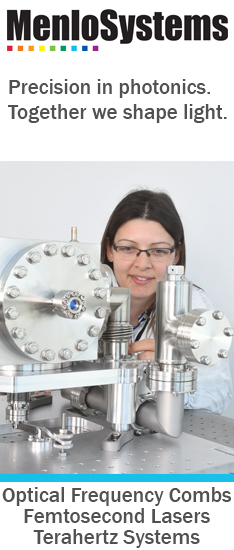Rod Lenses
Definition: cylindrical lenses with the geometrical form of a cylinder
More general term: lenses
German: Stablinsen
How to cite the article; suggest additional literature
Author: Dr. Rüdiger Paschotta
A rod lens is a cylindrical lens which has the geometrical form of a cylinder and has a polished mantle, while the two flat end surfaces may be ground. It is analogous to a ball lens for focusing in both directions.
Rod lenses can be used, for example, for collimating a divergent beam in one dimension (see Figure 1) or for focusing light to a line. There are also imaging applications. Note, however, that a rod lens exhibits substantial spherical aberrations when light propagation is not restricted to a small fraction of its cross-section.
Note that there are also gradient-index lenses which also have a cylindrical shape. There, however, the two end faces are polished, and the mantle surface is not optically relevant.
Types of Rod Lenses
Rod lenses are available with different optical materials, mostly with glasses like fused silica and BK7, but also with crystalline materials like YAG or silicon, e.g. for infrared optics.
Rod lenses can have diameters of a few millimeters, but there are also cylindrical microlenses with substantially smaller diameters. Small-diameter rod lenses are frequently used as fast-axis collimators for diode bars.

There are also half-rod lenses, which are rod lenses cut into two equal pieces.
Focal Length
There are two different definitions of focal length of a rod lens. The effective focal length, which is the distance between a plane through the center of the lens and the beam waist (focus) of an initially collimated input beam, is given by the equation
where D is the diameter of the lens cylinder and n its refractive index.
The back focal length is defined as the distance of the focal point from the lens surface, and is smaller than the effective focal length by half the diameter of the rod.
Suppliers
The RP Photonics Buyer's Guide contains 11 suppliers for rod lenses. Among them:


Shanghai Optics
Shanghai Optics custom rod lenses are polished on the circumference and ground on both ends. They act as a cylinder lens, focusing collimated light into a line. Our fused silica rod lens offers high transmission in the UV and through the NIR as well as a low coefficient of thermal expansion, 0.55 × 10-6 /K.


Knight Optical
Knight Optical’s rod lenses are available in four varieties; plain, 45º type, laserline generator and graded-index (GRIN) type. Our plain range of Lenses can be manufactured in borosilicate (or equivalent) substrates for the visible and near-infrared (NIR) wavelengths, or UV-grade fused silica for applications working in the ultraviolet (UV) spectrum – down to 185 nm. 45º type, laserline generator and graded-index (GRIN) types are available as custom-made optics only.

Artifex Engineering
Artifex Engineering offers custom rod lenses for various applications such as endoscopes. A wide range of substrates are available in custom sizes, specifications and coatings to suit your requirements. We look forward to your inquiry.


Edmund Optics
Designed for use in a variety of laser and imaging systems, these components are available in a range of micro sizes for integration into a host of OEM applications. Custom sizes, variations in polishing/ ground surfaces and additional coatings are available upon request.
TECHSPEC® rod lenses are polished on the circumference and ground on both ends. Optical performance is similar to a cylinder lens. Collimated light passing through the diameter of the rod lens will be focused into a line. N-BK7 and UV fused silica substrates are available for a variety of UV, visible and NIR applications.
Questions and Comments from Users
Here you can submit questions and comments. As far as they get accepted by the author, they will appear above this paragraph together with the author’s answer. The author will decide on acceptance based on certain criteria. Essentially, the issue must be of sufficiently broad interest.
Please do not enter personal data here; we would otherwise delete it soon. (See also our privacy declaration.) If you wish to receive personal feedback or consultancy from the author, please contact him e.g. via e-mail.
By submitting the information, you give your consent to the potential publication of your inputs on our website according to our rules. (If you later retract your consent, we will delete those inputs.) As your inputs are first reviewed by the author, they may be published with some delay.
See also: cylindrical lenses, microlenses, ball lenses, gradient-index lenses
and other articles in the category general optics
 |




If you like this page, please share the link with your friends and colleagues, e.g. via social media:
These sharing buttons are implemented in a privacy-friendly way!